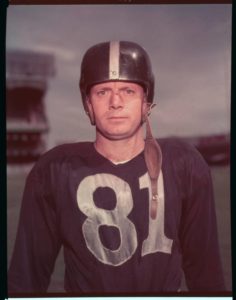Baltimore quarterback sensation Lamar Jackson is averaging 226.2 passing yards per game and 78.0 rushing yards per game so far this season. That is… well, remarkable. In fact, in the history of pro football, there has only been one player in NFL history to average 75 rushing yards and 75 passing yards per game: Orban “Spec” Sanders, playing for the New York Yankees in the AAFC in 1947.
The graph below shows the passing yards per game (X-Axis) and rushing yards per game (Y-Axis) for every player who played in at least 6 games from 1932 to 2018. As you can see, Sanders really stands out. For reference, I’ve also included Jackson’s 2019 season to date — he, too, is a pretty notable outlier.

You probably don’t think much about single-wing tailback Orban “Spec” Sanders these days. At the University of Texas, he was stuck behind stars Jack Crain and Tim Layden. And despite his backup status, Sanders went drafted in 1942… with the 6th overall pick! You might wonder how the heck a backup running back from Texas went with the 6th pick in the Draft. Well, it helped that Sanders excelled in relief (scoring 53 points in 1941) and did receive some recognition, but let’s just say that Washington coach Ray Flaherty — who would lead the Redskins to the title that year — had a good eye for talent when he saw.
After his time with the Longhorns, Sanders joined the Navy in 1942 and served during World War II, never playing a down with Washington. Flaherty also served in the Navy in ’42, leaving the Redskins for that higher calling. When the War was over, both Flaherty and Sanders joined the New York Yankees of the AAFC, and that’s where the fun begins.
In 1946, the AAFC was a brand new league, and the Yankees were one of the league’s top teams. And Sanders was the team’s best player. Sanders led the team with 9 of the team’s 30 offensive touchdowns (and threw for 4 more), and had 968 yards from scrimmage, significantly more than any other player. He split time with an aging Ace Parker (the old Brooklyn Hall of Fame tailback) when it came to the passing duties, but Parker would retire after the season. With Parker gone, and the Yankees adding Illinois star Buddy Young to the backfield, would set up Sanders’ 1947 season. Because while Sanders was an All-Pro who led the AAFC in rushing yards, yards from scrimmage, and all-purpose yards in ’46 (he also was an excellent returner), his 1947 season was legendary.Here’s what Yankees coach Ray Flaherty said about his team’s backfield in 1947, which featured the best player in the AAFC and Young, a 5’4 running back who was also one of the first black men to play pro football:
“Having Young alongside of him at fullback has doubled Sanders’ effectiveness this year. Buddy’s speed makes him an excellent decoy. Whenever we send him in motion, Young draws one or two defenders with him, which makes it a lot easier for Spec to run or find an open pass receiver.” [New York Times, Oct. 10, 1947, Joseph M. Sheehan.]
How good was Sanders? Against Baltimore, Sanders rushed 14 times for 140 yards, had 97 kickoff return yards on two kickoffs, completed 6 of 13 passes for 62 yards, and scored three touchdowns. Against Chicago, Sanders rushed 24 times for 250 yards in three quarters. Against the mighty Browns, Sanders scored the first three touchdowns of the game, to help the Yankees jump out to a 21-0 lead.
He returned 6 punts for 164 yards, and averaged 27.0 yards per kickoff return and also 42.1 yards per punt. He threw for 1,442 yards and 14 TDs, more than respectable numbers for that era. But where Sanders truly stood out was a rusher, as he rushed 231 times for 1,432 yards and 18 touchdowns, easily shattering the pro football single-season rushing yards record. By way of comparison, Beattie Feathers had been the only 1,000-yard rusher in NFL history prior to 1947, and Steve Van Buren rushed for 1,008 yards in the NFL in ’47. Van Buren (18) and Don Hutson (17) were the top two touchdown seasons in NFL history when Sanders scored 19 touchdowns in 1947. Sanders finished with over 500 more rushing yards than any other player in the AAFC, and had twice as many touchdowns as every other player, too.
The Yankees scored 27.0 points per game and went 11-2-1, second only to the Browns on both counts. You may recall that 1947 was the most remarkable season of Otto Graham‘s career, as he posted a 109.2 passer rating. But Sanders held his own among non-Graham passers in the AAFC that season, throwing touchdowns on 8.2 percent of his passes and averaging an impressive 8.4 yards per attempt. Playing in the single-wing truly showcased the versatile talents Sanders possessed, making him a perfect fit for Flaherty’s offense. And while there are a lot — and I mean a lot — of differences in the modern NFL, if you squint just right, you can see some of what Sanders did in 1947 in what Jackson is doing in 2019.

